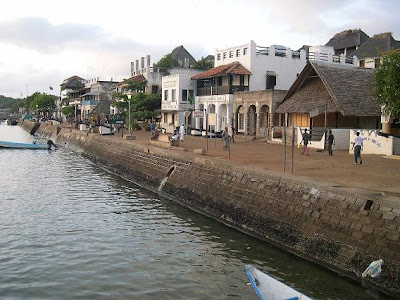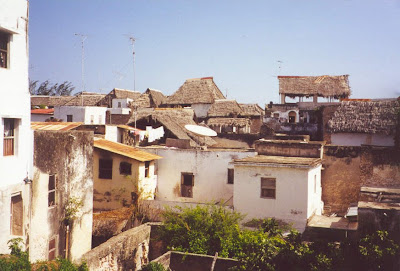First stop was Mombasa via an overnight trip on the train, billed as one of the remaining true British colonial-era experiences. And, although the food was a little disappointing (read: small portions and unbelievably bland), it was still cool eating the meals in a old style dining car, with tables still adorned with the original silverware from a hundred years past. We made a brief one day stopover in Mombasa to see Fort Jesus, supposedly the first building built in East Africa by foreigners and shaped to resemble Jesus on the cross; and the historic, and still incredibly Muslim 'Old Town' (complete with banners reading "Muslim Army for the Gaza Strip...").
Next stop was the town of Malindi, overrun by an incredible amount of Italians, with seemingly more restuarants serving pizza than local food. Main attraction there was the excavated (partially excavated anyway, the Kenyan government is still waiting for more international donors to help complete the considerable task) Gede Ruins, the remains of virtually an entire village from the fourteenth(?) century.
 The whirlwind tour of the Kenyan coast continued with Lamu,the furthest we would reach along the coast, as well as on our trip as a whole. As is becoming normal, we ended up staying longer than planned, discovering more things to see and do as we, well, saw and did things. A thirty minute ride away from the mainland, on an incredibly overloaded (both with people and goods, as is the norm in Africa) of dubious strength, the island of Lamu has retained much of its history and culture to this day, making the city in itself one of the foremost reasons to visit. At first glance, the buildings appear to be just a seemingly random assortment of oddly designed, ramshackle buildings. But up close, with a little attention, you'll quickly (we did anyway) come to appreciate the intricate and unique designs of each building.
The whirlwind tour of the Kenyan coast continued with Lamu,the furthest we would reach along the coast, as well as on our trip as a whole. As is becoming normal, we ended up staying longer than planned, discovering more things to see and do as we, well, saw and did things. A thirty minute ride away from the mainland, on an incredibly overloaded (both with people and goods, as is the norm in Africa) of dubious strength, the island of Lamu has retained much of its history and culture to this day, making the city in itself one of the foremost reasons to visit. At first glance, the buildings appear to be just a seemingly random assortment of oddly designed, ramshackle buildings. But up close, with a little attention, you'll quickly (we did anyway) come to appreciate the intricate and unique designs of each building.  Walking the narrow roads within the town is honestly, like nothing I've ever seen. The closest resemblence I can make to the town is something that I would imagine from one of the old Jesus films, or something similar that would have taken place in Biblical times anyway. One of the most unique, and quirky but oh so refreshing differences on Lamu, is that there are no cars, or motorised vehicles at all. Almost. We saw two small three wheeled vehicles labelled ambulances, as well as a tractor used for garbage collection, and a couple of motorcycles (which totally takes away from the ambience of Lamu) but other than that handful of vehicles, Lamu is a car free zone. The alternatives, walk, cycle, or, (no joke) ride a donkey. =)
Walking the narrow roads within the town is honestly, like nothing I've ever seen. The closest resemblence I can make to the town is something that I would imagine from one of the old Jesus films, or something similar that would have taken place in Biblical times anyway. One of the most unique, and quirky but oh so refreshing differences on Lamu, is that there are no cars, or motorised vehicles at all. Almost. We saw two small three wheeled vehicles labelled ambulances, as well as a tractor used for garbage collection, and a couple of motorcycles (which totally takes away from the ambience of Lamu) but other than that handful of vehicles, Lamu is a car free zone. The alternatives, walk, cycle, or, (no joke) ride a donkey. =) Anyway, just wandering the streets aimlessly (sometimes on purpose, other times because we were just hopelessly lost in the maze of misalligned streets) was truly like taking a step back in time. It got even cooler when we were walking down the main street at night and the power went out (a clear indication that while Lamu is like nowhere else we've visited, it is still a part of Africa), plunging the town into near pitch black. Despite it being a full moon, the streets were too narrow to allow any light to get through. Just seconds passed though, before shopkeepers were lighting candles, or, for the slightly more technologically advanced, oil lamps, illuminating the shops, the street, and all the people in the welcoming gentle glow that light bulbs just can't provide.
Anyway, just wandering the streets aimlessly (sometimes on purpose, other times because we were just hopelessly lost in the maze of misalligned streets) was truly like taking a step back in time. It got even cooler when we were walking down the main street at night and the power went out (a clear indication that while Lamu is like nowhere else we've visited, it is still a part of Africa), plunging the town into near pitch black. Despite it being a full moon, the streets were too narrow to allow any light to get through. Just seconds passed though, before shopkeepers were lighting candles, or, for the slightly more technologically advanced, oil lamps, illuminating the shops, the street, and all the people in the welcoming gentle glow that light bulbs just can't provide. Other highlights on Lamu include an overnight trip on a dhow, a traditional Swahili style sailboat. Although we didn't think the trip was all that it had been hyped up to be, it was still a cool experience sailing in one of the very unique dhow boats, that are only to be found on along the east coast of Africa.
Other highlights on Lamu include an overnight trip on a dhow, a traditional Swahili style sailboat. Although we didn't think the trip was all that it had been hyped up to be, it was still a cool experience sailing in one of the very unique dhow boats, that are only to be found on along the east coast of Africa. The best day on the island may have been the day we found camels, or rather, we were found by camels. You see, we'd spotted four camels just lounging on the beach on the first day we went to the beach. Turns out that they're there for hire, imported from Somalia to give those who want, a chance to ride a camel. We weren't all that interested in riding the camels, but we'd chosen one of the only shady spots on the beaches and the camels weren't afraid to come and settle down right next to us. A short time later, we ended up befriending Fiki and Juma, the guys in charge of the camels, and we spent the afternoon just chatting, sharing a couple of beers, while using the resting camels as our backrest. We then stopped by their village on the way back to town for some fresh locally brewed coconut wine (really more just like coconut juice becuase it hadn't yet fermented, but still pretty good stuff, especially at just a dollar a bottle =p), taking the scenic route through some massive sanddunes (I don't remember the ones in Oregon even being as big as these) with Fiki teaching us how to do backflips down the sandy hills (I didn't quite master this one though).
And, as is always a highlight and one of my favourite parts of traveling, we met a bunch of really cool people on Lamu. From Juma and Fiki, the two backflipping, camel riding beach boys, to the crew on our dhow trip (we never did catch all their names), to Ali Hippie and his singing family (one of the most random nights on the island, but definitely one of the most memorable), we made a number of really cool and hospitable Lamonians (I think that's how you spell it..). Then, the long list of other travellers and aid workers that we met in various places, each of them with their own stories, experiences and reaons for being there. From a bunch of German medical students (there are an unbelievable number of them serving in East Africa!), to a couple of peace corps workers from California and their teacher friends, to a British guy who biked all the way to Kenya from England to raise money for an NGO (yea, crazy!), to a couple of Canadians who were working in Ethiopia until, thanks to Stephen Harper's new policies, CIDA cut their project's funding. I can't list all the people we met, mainly cause I can't recall all of them right now, but it really is one of the reasons to travel. And, for me anyway, it was really encouraging to see so many other people, some who had sacrificed substantial financial and other gains, working to improve the lives of others.
Sweet post, broseph. Probably the best one yet...
ReplyDelete